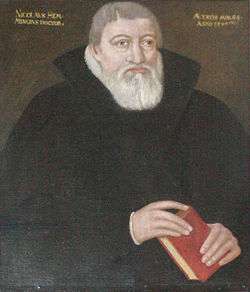Niels Hemmingsen
Niels Hemmingsen (Nicolaus Hemmingius) (1513 in Taagerup – 1600 in Roskilde) was a Danish Lutheran theologian. He studied at the University of Wittenberg 1537 to 1542 under Melanchthon. Returning to Denmark, he became a prolific author of works in Latin. In 1574 he published Syntagma institutionum christianarum, but was obliged to retract it in 1576 following pressure from Augustus, Elector of Saxony to suppress Crypto-Calvinism.[1]

In 1575 he published Admonito de superstitionibus magicus vitandis, a warning against practicing witchcraft. This was an important text on demonology and witchcraft in the 16th Century. He used a wide definition of witchcraft, including not only harmful activities, but all superstitious and magical behavior.[2] Not all witches had pacts with the devil. Witchcraft and magic were breaches of the first two Commandments, idolatry and sacrilege.[3] He wrote that most of the Devil's power came through illusions and that witches only did physically impossible things in dreams, like flying on brooms. Hemmingsen found drowning tests unreliable since they relied on superstition that the Devil could manipulate.
In 1579 Frederick II suspended Hemmingsen from his teaching role at the University of Copenhagen after representations from his brother-in-law, Augustus, Elector of Saxony, husband of Anne of Denmark.[4]
Hemmingsen met James VI of Scotland at Roskilde on 11 March 1590 and they had a long discussion or debate in Latin on theological issues and predestination. James VI, who had owned four of his books since 1575,[5] gave him a silver gilt cup. The English ambassador in Scotland, Robert Bowes heard they disagreed about predestination[6]
References
- Bayle Dictionary, English edition
- Gilje, Nils. 2003. Heksen og humanisten: Anne Pedersdatter og Absalon Pederssøn Beyer, pages 202-205. (Norwegian)
- 'Tycho Brahe's German Treatise on the Comet of 1577: A Study in Science and Politics' by J. R. Christianson and Tycho Brahe Isis Vol. 70, No. 1 (Mar., 1979), pp. 110-140
- Louise Nyholm Kallestrup, Agents of Witchcraft (Palgrave, 2015), p. 43.
- Louise Nyholm Kallestrup, Agents of Witchcraft (Palgrave, 2015), p. 47.
- Louise Nyholm Kallestrup, Agents of Witchcraft (Palgrave, 2015), p. 42.
- G. F. Warner, Library of James VI (Edinburgh, 1893), p. xlviii.
- David Stevenson, Scotland's Last Royal Wedding (Edinburgh, 1997), pp. 49, 99, 131.